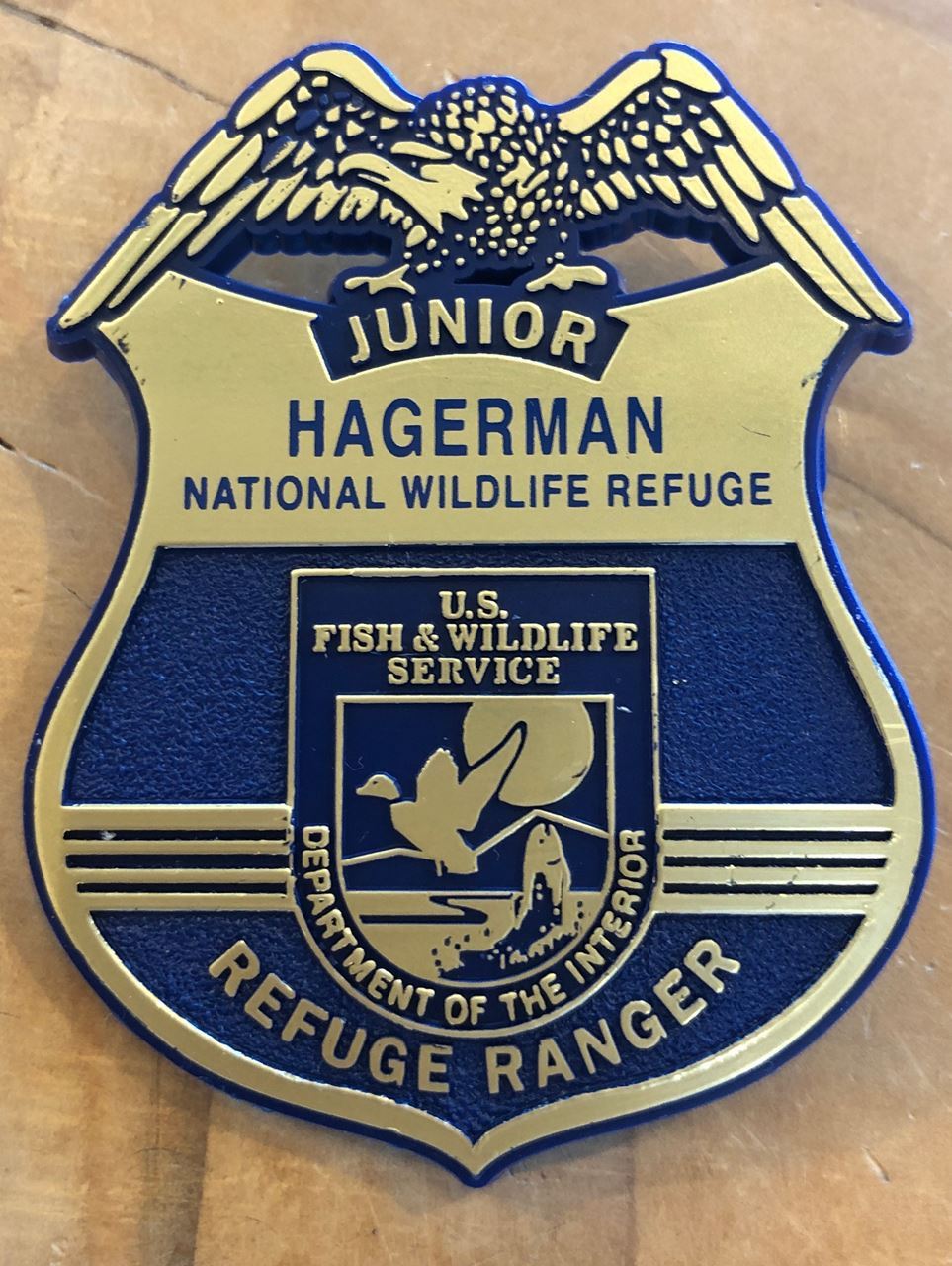Rewilding Sticker Hill
By Karen Glenn, Texas Master Naturalist
What a Spring it has been! The rain has certainly made things grow around here. I have noticed a lot of small persimmons on the ground, so the crop is probably not going to be very big this year. I am not sure if it is from water-saturated soil, but many of the unripe fruitlets are on the ground. We received over 9 inches of rain in May and over 4 inches, so far, in June. What a wet season, but thankfully things are beginning to dry out a bit. It was a fun time to pull invasive plants up, though. The privet is taking over this year. Every time I go outside a new privet sprout or bush is hiding in the understory!
Once the sun came out this month the plants on the property grew like weeds. Speaking of “weeds”... the current star of the landscape this month is tall gaura, aka longflower beeblossom or Oenothera filiformis. This plant is no longer considered a species of gaura and has since been reclassified in the Onagraceae, or Evening Primrose Family. Old habits die hard. I will probably always call it gaura. Most people consider this plant a weed, but I have learned to embrace and appreciate it here on the farm. Tall gaura was introduced here by a round bale of hay, collected next to the Fobb Bottom Wildlife Management Area, near Willis, Ok. Those bales of hay came with tons of wildflower seeds, which most ranchers would be upset about, but I was thrilled! I first noticed it in the pasture in 2012, and now it is everywhere I look. Photo: The "weed" of the month, tall gaura, aka longflower beeblossom or Oenothera filiformis. This is a tall native plant with delicate pink and white flowers that blooms from June until November. My number one rule on this property: If it is being used by local wildlife, birds, or beneficial insects, it stays. Rule number two: If it stays, it has to learn to share its space well. Gaura follows both rules, so it stays, for now. This plant knows how to share the landscape, with a little attention. This year it is mixed with another tall pollinator plant, late boneset (Eupatorium serotinum), and they are both sharing space nicely. Gaura is a tall annual on my place and reseeds in thick patches, so it sort of takes over empty space. The good news: it cannot | Sponsor the Friends With Membership Morning Tram Tours on the Wildlife Explorer! Early Bird Walks are Cancelled Due to Heat Gardening, Mowing and Work Crew Visitor Center Volunteers Needed! Subscribe to Our Monthly Featherless Flyer |
stand mowing and pulls out of the soil easily, so it is easy to keep out of an area you do not want. Just note that if left on its own it will ramble. What I like most about gaura is the amount of cover it gives for small mammals and birds to forage underneath, as well as its place in the plant community on the farm. We tend to get mostly colorful songbirds nesting on the property, and the tall gaura gives them foraging cover and protection from overhead predators, like the local Cooper’s hawks.
Tall gaura is also an “airy” plant, which allows dappled sunlight to reach the ground. The plant is very leggy with a strong central stem and very few lower leaves. It will drop lower leaves throughout the growing season, until it is basically flowering tops waving in the breeze by fall. This allows other plants to grow and fill in the spaces close to the ground. Perennials will eventually push the shallow-rooted gaura out of the way as they become established, so it has enabled desirable native forbs to self-seed, germinate, and become established in the pastures. This eventually gave me the idea of using small, circular clearings in the gaura thickets as protected areas to help reestablish native grasses and forbs in the pastures. Opening up the space allows desirable perennials to have the sun they need while protecting them from high winds and competing neighbors. Unwanted gaura is easily mowed, pulled up, or cut at the base with loppers. It has worked pretty well in the areas where this method was used.
Another wonderful thing about tall gaura is its generous gift to the native cavity-dwelling wasps and bees, who count on having sturdy stems to raise their brood and overwinter. Birds also use the stems to perch and feed on the winter seeds left behind. If the stems are in an unwanted area, they are easily moved to another part of the yard, so the wildlife still has access to the substrate to help them survive the winters. At first it was tempting to remove all the stems left behind, but I have found having a little patience pays off. Almost all of the stems will drop to the ground and go back into the soil by Spring. If cleaning up is necessary, try to wait until the warmer months |
of Spring before removing the plant material from the property. This gives the pollinators resting inside a chance to emerge and move on to greener pastures. Photo: Early May on the farm (2023) the arrowleaf clover, Trifolium vesiculosum is filling in space. There are dried stalks of last year’s tall gaura, Oenothera filiformis, still peeking through the vegetation. Most of the stalks have fallen over and are returning to the soil. In another month gaura will dwarf the clover! While you may not want to let this plant take over your place, Oenothera filiformis is a great native for naturalizing an area. Just be aware that it will crowd out shallow rooted grasses, which was a plus for me, as I was trying to get rid of coastal Bermuda and stickers. It has been quite effective. It is now difficult to find a sticker on Sticker Hill! Everything cycles through this landscape, so if I don’t like the view, I know it will change in just a few weeks. Meanwhile, I will share this space with the native plants and critters and realize that we all must learn to share the space that we live on. Rewilding is teaching me to relax and enjoy the cycles in nature. I hope to continue sharing some of these experiences with you as the seasons change here on Sticker Hill. Footnote: Sticker Hill is the nickname of a small hobby farm, located in far northwest Grayson County, near Gordonville, Texas. The property sits in the East Cross Timbers ecological region of north Texas, where the Blackland Prairie meets the post oak/hardwood forests. Beginning in 2018 the property became an experiment in rewilding or returning the land back into native habitat for songbirds and native pollinators. The farm consisted mostly of coastal Bermuda, sandburs, and cockleburs when the project started, but slowly the property is returning to a diverse mixture of native trees, deep-rooted prairie grasses and native forbs (flowering plants). The small acreage now hosts over 120 distinct species of plants and animals (and counting). |
Upcoming Activities:
The Friends of Hagerman NWR are hosting 15 family-friendly events in July Donate to help fund programs like these! |
|
Tons of Fun at the Refuge in June! |
THE RAPTORS ARE COMING! THE RAPTORS ARE COMING!
Photo by Pam Rendall-Bass The Refuge Roundup is October 12, 2024! Join us for a full day of family fun at our biggest event of the year! The event will include:
|
Volunteer Help Wanted! Are you proficient with MS Office and want to make a difference volunteering from home? The Friends of Hagerman NWR are looking for webmastering help:
Also needed: Professional accounting and Visitor Center volunteers |
|
Plant of the Month: American Beautyberry
By Shawn Stone The name really says it all, the wonderful and striking characteristic of this shrub is the bright glossy purple berries that cover the branches of the plant in fall. Also known as French Mulberry, American Mulberry, Sour-bush, and Sow-berry it is a native of the eastern half of Texas through the eastern US to Florida and up to Virginia. There are also white berry varieties and an Asian Beautyberry that is similar, but the native form is the most adaptable and showy in the fall. Beautyberry is an open, deciduous shrub that prefers morning sun and afternoon shade and grows about 4-6 ft tall and wide. It will adapt to many soil types but prefers moist soil and will need watering in hot, dry summers. The branches are arching with large oval leaves with toothed margins, somewhat resembling mulberry leaves, leading to some of the alternative names for the plant. The leaves have mild mosquito-repelling qualities as well. The flowers and resulting berries hug the branches of the plant along the leaf axils. The flowers are small, greenish-white, barely noticeable, and bloom through summer. The REAL show starts around September when the brightly colored berries appear. |
|
|
As a native plant to Texas, it provides food for a long list of birds and animals. Deer will feed off the leaves in spring and summer, and the flowers will attract pollinators throughout the summer. In the fall, the berries have a high moisture content and provide food for more than forty species of songbirds including the American Robin, Brown Thrasher, Purple Finch, and Eastern Towhee. Berry clusters are also eaten by armadillos, foxes, opossums, raccoons, and squirrels.
The berries are edible for human consumption but taste bitter if eaten fresh. However, they apparently lend themselves to a wonderful jelly with a mild flavor similar to grape jelly, and there are a number of recipes online, including this one from Southern Living.
For more information visit:
Hagerman Bluebirds: Mid-Season Update
46 boxes are monitored each week on either Raasch Trail or Harris Creek Trail.
Statistics: 46 nesting attempts for all birds--Bluebirds, Chickadees, Titmouse (some boxes have had several different nests in them). 230 eggs laid for all birds 192 eggs hatched - Bluebirds 164 birds have fledged - Bluebirds |
|
Birding with Jack: The Weekly Bird Census Left to Right: Mike Petrick, Nancy Riggs, Jack Chiles and Terry Goode Each Tuesday a team of experienced birders, including Master Naturalist Jack Chiles, traverse 35 miles of refuge roads and hiking trails, documenting every bird they encounter. This Bird Census is reported to The Cornell Lab of Ornithology for use in research, and each week we will bring you a link to their actual bird count, and a summary of their adventures. June 25, 2024 Complete Bird Census 61 Species Observed, 913 individuals
American Kestrel It was a partly cloudy day that heated up quickly. Bird activity dropped off quickly after about 09:30. The Barn Owls were still present and we counted 3 in the box. There are now large numbers of Canada Geese present with a count of 206 including many young of varying ages. They like to hang out along the edges of Wildlife Drive. Bennett Lane is now open and the low water crossing on Bennett is now passable. We saw 4 Red-headed Woodpeckers on the road to Meadow Pond. They are present at Deaver and along the road just past Deaver Pond. We found Wood Ducks at Dead Woman Pond. Since the north low water crossing is still closed we had to take the long way around via Terry Lane to get to the Goode Area. We counted 40 Killdeer and the only other shorebird we saw was a single Long-billed Dowitcher. Purple Martins are beginning to bunch up and we saw them at several locations. Plover, Tern and Egret pads are still closed and probably will be for the rest of the week. We finished the day with 61 species. Today's photo, an American Kestrel. See the rest of Jack's notes and the latest Bird Census Results |
Friends of Hagerman NWR Annual Nature Photo Contest The 15th Annual Friends of Hagerman National Wildlife Refuge (HNWR) Nature Photography Contest sponsored by the Friends of Hagerman NWR is open to photographers of all ages and skill levels. Youths aged under 18 are encouraged to enter and compete in the Beginner category. Ribbons and cash prizes are awarded in multiple divisions and categories, with a unique Best in Show for Youth. Judges are asked to consider composition, originality, and visual impact. Winning photographs will be announced in November 2024. Overview
|
Join Cindy Steele for: The Refuge Rocks! Programs for Children Future events (Registration Required)
|
| Puddles' Craft Corner By Cindy Steele, Master Naturalist |
Sunflowers…Summer’s Sunny Stars!

When we think about sunflowers, we think about warm and sunny summer days.
The sunflower is a bright, beautiful, and bold flower which has inspired some amazing pieces of art, poems, and stories through the years. Those beautiful bright yellow flowers are enough to brighten your day. They bring up thoughts of long lazy summer days that stretch out from early dawn to late dusk, swimming, fireflies, and the sounds of the ever- present summer cicadas. Sunflowers are the unofficial symbol of summer!
History of Sunflowers
Sunflowers aren’t just beautiful flowers, they’re useful plants that have been used for healing, food, and oil for thousands of years.
Sunflowers are believed to have been grown by American Indians in Arizona and New Mexico about 3000 BC. They were used in many ways – the seed was ground or pounded into flour for cakes and bread or cracked and eaten for a snack, the meal was mixed with other vegetables such as beans, squash and corn and the oil was squeezed from the seed and used in bread making too. Non-food uses include dye for textiles and body painting. Some parts of the plant were used for medicinal purposes including treating snakebite, the oil of the seed was used on the skin and hair and the dried stalk was used as a building material.
Sunflowers were taken to Europe by Spanish explorers around 1500 and the plant became widespread throughout Western Europe, for ornamental and medicinal purposes. In the 18th century sunflowers became popular in Russia too. This is mostly credited to Peter the Great, but the Russian Orthodox Church also played a part by forbidding most oil foods from being consumed during Lent. As sunflowers were not on the prohibited list, they became popular...
Continue the Lesson and Full Instructions and other Nature Crafts with Puddles
Junior Ranger Program
|
| The Junior Ranger Pledge As a Junior Ranger at Hagerman National Wildlife Refuge, I pledge to protect outdoor creatures small, big and huge. To keep the water, air and land clean. To make enjoying nature a routine. I will share my new skills with family and friends. When people and nature work together, everybody wins! |
|
Sponsors Enable the Friends to…
Join Today! Memberships available for $10 |
Come, Take a Tour on the Wildlife Explorer! New! 10 AM Tours to Beat the Heat! Come join us for a ride on the Wildlife Explorer! Our new and beautiful tram is available for ninety-minute tours of Hagerman every Saturday and Sunday, weather permitting. Our tours are as varied as our drivers. Each tram driver has her/his approach to the tour: you may learn about wildlife, birds, habitat, refuge history, photography, you name it! To paraphrase, “a Wildlife Explorer tour at Hagerman is like a box of chocolates, you never know what you’re going to get.” But you know it’s going to be good! Come see us! Lots of stops for bird-watching and photography. |
Register for a Tram Tour Today! |
Group Tour Request |
|
Butterfly Garden Walks
Registration is not necessary |
Pipevine Swallowtail (right) by Laurie Sheppard |
Sunrise at the Little Sit by Laurie Sheppard | Photo by Cathy Van Bebber |
Meet Jack and the Bird Census Team and learn how to identify the birds of North Texas while enjoying the beautiful sunrise over Lake Texoma! Modeled after Cornell's national "Big Sit" event, a group of dedicated birders invite you to join them at sunrise to conduct a bird count as multiple species fly to the water and the surrounding land to feed. Leaders will bring spotting scopes and will provide tips for identification of the many species you will see. This event lasts a couple of hours, but all are welcome to come and go as they please. Participants are advised to bring a chair, binoculars and water. The First Saturday of every month, beginning 30 minutes before sunrise. |
Location: H Pad, Sadler, Texas 76264 (H Pad is in Sadler, but it is part of the refuge) GPS Coordinates: 33.734961, -96.780582
|
|
Second Saturday: Wading Birds with Dr. Wayne Meyer Saturday, July 13 at 10:00 AM in the Visitor Center Little Blue Heron by Pam Rendall-Bass Hagerman NWR has a great number of water birds. In the winter they are mostly ducks and geese. In the spring and fall they are mostly sandpipers and plovers. In the summer, they are mostly waders, the herons and egrets. This month’s talk will discuss how waders are different from the others and will examine how to identify them. Dr. Wayne Meyer is Associate Professor of the Biology department at Austin College, where he has been teaching for 30 years. He started birding at 13 in Connecticut. In 1993 he finally achieved his life’s dream of being paid to look at birds when he joined the faculty of Austin College. He has birded both coasts of the U.S. extensively and now has spent a quarter century birding in Texas and Oklahoma. The proximity of Austin College to Hagerman NWR has made research on prairie birds easy and convenient and he has been studying song learning and singing in Painted Buntings for over a decade. Meyer is also a sought after speaker for Master Naturalist groups and a frequent speaker at the Friends of Hagerman NWR second Saturday programs. Future Second Saturday Programs |
|
|
Do You Like to Work Outside? The Refuge Needs You! |
It takes a lot of people to have a beautiful garden! The Wednesday Garden Team Love to work with native plants and meet other gardeners? Come and help us add plants, weed and mulch our beautiful butterfly garden. Garden Team volunteers get first dibs on thinned native plants as well as access to seeds and cuttings for propagation. Gardeners meet on most Wednesdays, but times vary. Contact Us to subscribe to the volunteer garden team weekly email. Provide own tools and gloves. Minimum age 18, or 16 if accompanied by parent/volunteer. |
Mowing and Refuge Beautification: The Work Crew Do you enjoy working outside, mowing, sprucing up hiking trails, trimming and removing brush and general cleanup? Show your love for nature by joining the Outdoor Crew at Hagerman National Wildlife Refuge. Outdoor Crew volunteers meet on the First Tuesday and Fourth Saturday of every month. Contact Us for exact times, dates and other details about joining the volunteer Work Crew. Scouts welcome! |
Visitor Center Volunteers Needed! |
Do you enjoy meeting all kinds of people from all over the world, and like-minded people in our area? If yes, consider joining our team of Visitor Center Volunteers. You will greet refuge guests, distribute maps and other refuge information, and make sales in the gift shop. Shifts available every day of the week: Monday through Saturday 9 AM to 12:30 PM and 12:30 to 4:00 PM, Sunday 1:00 to 5:00 PM. Training is provided. Contact Us if interested. |
| Thank You To Our Contributors: Jack Chiles, Cindy Steele, Karen Glenn, Pam Rendall Bass, Vincent Anthony Loza, Shawn Stone Refuge Manager: Kathy Whaley Deputy Refuge Manager: Paul Balkenbush Visitor Services Manager: Spencer Beard Friends of Hagerman NWR Foundation 6465 Refuge Road, Sherman, TX 75092 Phone: 903-786-2826 Join us on Facebook: |
Search for any word--do not use quotes for phrases |
Kroger: Stop by the customer service desk at Kroger and link your Kroger Card to the Friends of Hagerman: the Friends will get rewards for every dollar you spend, at no cost to you.
Please add info@friendsofhagerman.org to your contacts to ensure delivery of registration confirmations, account information and the Featherless Flyer
See you at the refuge!






















